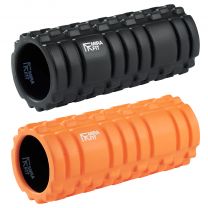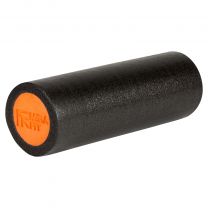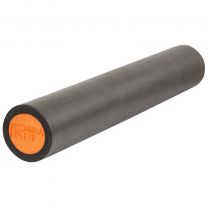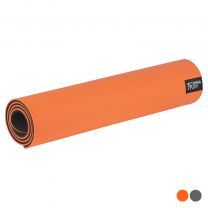7 Best Foam Roller Exercises
7 Best Foam Roller Exercises

If you’re not already using a foam roller, then you’re missing out.
And they’re not just good for helping with tension, knots and sore muscles but they can really help you with your training too.
We spoke to Becky Hair, who is a personal trainer, physio and triathlete about why she thinks foam rolling is a vital part of training.
Benefits of foam rolling
- Muscle activation - which in turn can improve your performance.
- Flexibility and joint mobility - especially around your hips and knees.
- Recovery - foam rollers help to increase blood flow which in turn can help your muscles recover after a hard training session.
- Rehabilitation - after an injury, muscles can be particularly tight. Foam rollers can help you ease tension so you can return to having a good range of motion.
- Saves you money - regular massage will help keep your muscles in good condition, helping you to avoid paying out for a sports therapist so often.
- Great if you work in an office - sitting down all day can result in tight glutes, hips and hamstrings. Using a foam roller can really help ease tension as well as wake up your muscles so you can move more easily.
What does a foam roller help with?
Foam Rollers allow you to use your bodyweight to perform self-myofascial release (SMR). Fascia is the sheet of connective tissue that lies beneath the skin and separates muscles from other internal organs.
As you train, the fascia becomes restricted and inflamed. When this happens, it starts to thicken which can feel painful.
It's also possible to develop trigger points in the fascia which form like knots in the body. These are sore points which can also twitch as you compress them.
By using the foam roller on these areas, you can release the tension and improve range of movement around your whole body.
Best foam roller exercises
There are two different types of foam roller. Those with ridges known as our High-Density Foam Rollers. And those that are smooth which are known as our EPE Foam Rollers. These are Pilates rollers.
They both can be used for a variety of exercises: the EPE roller is better for more sensitive areas such as your hips. And the ridged foam roller is great for your hamstrings and lats.
The exercises are broken down below, I have explained how to perform each one, so you can easily replicate the exercises at home or in the gym.
1 - Hamstrings

Lie one leg across the foam roller. Use the other leg to support your body and move your relaxed leg across the roller. Repeat on the other side.
2 - Glutes

Sit on the foam roller and bend one leg up and across the other so that your glute muscle is stretched out. Position yourself so that you’re at a slight angle to make sure you roll the main part of your glute. Use your supporting leg to move the roller across your glute and back. Repeat on the other side.
3 - Hip flexors

It’s common for runners to have tight hip flexors, as well as anyone who spends all day sat down. EPE rollers are best for working the hip flexors as they are softer and will help you relax as you roll. Lie across the roller at a slight angle so you target one side. Gently roll from side-to-side and then repeat on the other side.
4 - IT band

You can use either roller for this exercise. Lie across the roller with your supporting leg bent to help you move. Slowly roll up and down the roller to work your IT band, concentrating on hitting the sides of your quads rather than just the front. Repeat on the other side.
5 - Calves

Support your weight with your hands and relax one leg across the foam roller. Push your leg across the roller to work your calves making sure you target all the way down from under your knee to your ankle. Repeat on the other side.
6 - Quads

Lie across the foam roller so that you target one leg at a time. Roll gently up your quad from your knee to your hips and back down again. Repeat on the other side.
7 - Lower back and hips

With the foam roller under your hips, bring your knees into your chest. Support your body by taking your arms out to either side. Slowly bring your knees down to one side while keeping them bent. Then move them down over to the other side. Repeat.
It’s best to use an EPE roller for this exercise.
Is foam rolling better than stretching?
Although both foam rolling and stretching can help with muscle tension, they are different things.
Foam rolling can be done both before and after a workout to help both muscle activation and recovery.
Stretching can be split up into two different types:
• Dynamic stretching
• Static stretching
Dynamic stretching can be done before a workout to warm up. And static stretching can be done after a workout to increase flexibility.
If you’re looking to ease tension in a particular area, then a combination of foam rolling, stretching and strengthening is the most effective approach.
Strengthening, in particular, is important, because muscles can sometimes tighten because an area is weak. So, stretching and foam rolling will help the symptoms and gentle strengthening exercises can help treat the cause.
If you’re not sure however, it’s always good to speak to a trained physiotherapist who will be able to advise you.
Is it good to foam roll after running?
Running – especially long-distance running – can make your lower body muscles feel very tight. So, foam rollers are especially useful for anyone who runs regularly.
The IT band, or Iliotibial Band, is a thick section of tissue that runs down the outside of the thigh from the hip to the shin. Inflammation of this area is particularly common in runners and can make your legs feel very tight and sore.
A combination of regular foam roller work and stretching is ideal for runners as this helps to keep the IT band supple, so the pain is less likely to return.
In addition, it’s also really important for runners to complement their training with a strengthening routine.
Many runners tend to focus on improving their PBs as well as mixing up their runs with both long and short sessions. This can mean, however, that strengthening gets forgotten about. And this, in turn, can result in weaknesses, imbalances and injury.
So, as well as stretching and using a foam roller, it’s important to do lower body exercises regularly to help keep everything in good condition.
If you’d like to know more about this, check out our lower body workout for injury prevention.
Are foam rollers good for your back?
Many of us experience tension in-between our shoulder blades. And the causes can be anything from stress, to weakness to poor posture.
Instead of using a foam roller for your upper back, you can target knots more easily and more effectively by using Massage Balls. Simply lie on the floor and place the ball under the knot. Press and hold for 30 seconds and then release. You can also lean up against a wall to massage your upper back.
Foam rollers dos and don’ts
If you haven't used a foam roller before, here are a few tips for getting you started:
Do
• Use a foam roller regularly
• Massage tight muscles slowly and carefully
• Stay relaxed while using a foam roller
• Target trigger points
• Use over joints to improve range of movement
Don’t
• Use a foam roller on sore areas for too long as it can further inflame the area
• Use a foam roller that’s too hard on areas where there is less muscle – this can cause bruising
How long should I use a foam roller?
Use a foam roller for around 20-30 seconds for each area. You might want to spend a little longer on your quads and hamstrings for example, as these are larger muscle sets.
Remember to move slowly and keep your muscles relaxed as you foam roll. This will help ensure you reach the areas you’re targeting.
Foam rollers are great for keeping at home and just bringing out whenever you need them. You can use them before you train to encourage muscle activation. And you can use them after your gym session to help manage recovery.
For more content, follow us on Instagram, YouTube, TikTok, and on our official Mirafit Facebook page.
Enter your email to signup to our newsletter
Tags: Equipment > Rollers ; Exercise Type > Warm Ups & Cool Downs ; Misc > Recovery








